Andhra Pradesh is a state that is dotted with several historical ruins even if they are in ruins. Its cities, such as, Hyderabad, itself is a key witness to the state`s cultural growth. Travelers will surely come across several monuments of historical and cultural significance.
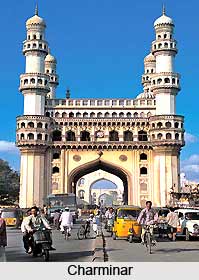 One of the premier tourist destinations in Andhra Pradesh is Charminar, Hyderabad. A maze of bazaars teeming with people, the old city has at its heart, the Charminar or Four Towers. It is a triumphal arch built at the centre of Mohammed Quli Shah`s city in 1591 to commemorate an epidemic. As its name suggests, it features four graceful minarets, each 56 metre high, housing spiral staircases to the upper storeys. The mosque on the roof is the oldest in Hyderabad; it was built to teach the royal children the Koran. The yellowish colour of the building is due to special stucco made of marble powder, gram and egg yolk.
One of the premier tourist destinations in Andhra Pradesh is Charminar, Hyderabad. A maze of bazaars teeming with people, the old city has at its heart, the Charminar or Four Towers. It is a triumphal arch built at the centre of Mohammed Quli Shah`s city in 1591 to commemorate an epidemic. As its name suggests, it features four graceful minarets, each 56 metre high, housing spiral staircases to the upper storeys. The mosque on the roof is the oldest in Hyderabad; it was built to teach the royal children the Koran. The yellowish colour of the building is due to special stucco made of marble powder, gram and egg yolk.
Charminar marks the beginning of the fascinating Lad Bazaar, as old as the town itself, which leads to Mahboob Chowk, a market square featuring a mosque and Victorian clock tower. Lad Bazaar specializes in everything one could possibly need for a Hyderabadi marriage. It is full of bangle shops, old stores selling rosewater, herbs and spices, and material. The tourists will also find silver filigree jewellery, antiques and hookah-paraphernalia with delicate inlay work. In the markets near the Charminar pearls are found in abundance. Today Hyderabad is the centre of India`s pearl trade.
The Salar Jung Museum in Hyderabad is open for visitors daily except Fridays from 10am-5pm. It is conveniently located on the south bank of the Musi. The museum houses part of the huge collection of Salar Tuna, one of the nizam`s prime ministers and his ancestors. A well-traveled and affluent man he bought whatever took his fancy from both the East and West. His extraordinary hoard includes Indian jade, miniatures, furniture, lacquer-work, Mughal opaque glassware, fabrics, bronzes, Buddhist and Hindu sculpture, manuscripts, and weapons.
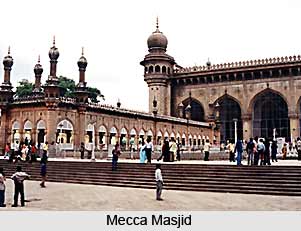 Southwest, behind the Charminar, Mecca Masjid is the 6th largest mosque in India that was constructed in 1598 by the sixth king, Abdullah Qutb Shah, with locally hewn blocks of black granite. Small red bricks from Mecca are slotted over the central arch. The mosque can hold 3000 devotees with up to 10,000 more in the courtyard; on the left of the courtyard are the tombs of the nizams. The Charkaman or Four Arches, north of Charminar, were built in 1594 and once led to the parade ground of royal palaces. The western arch, Daulat-Khan-e-Ali, was at one time adorned with rich gold tapestries.
Southwest, behind the Charminar, Mecca Masjid is the 6th largest mosque in India that was constructed in 1598 by the sixth king, Abdullah Qutb Shah, with locally hewn blocks of black granite. Small red bricks from Mecca are slotted over the central arch. The mosque can hold 3000 devotees with up to 10,000 more in the courtyard; on the left of the courtyard are the tombs of the nizams. The Charkaman or Four Arches, north of Charminar, were built in 1594 and once led to the parade ground of royal palaces. The western arch, Daulat-Khan-e-Ali, was at one time adorned with rich gold tapestries.
Hussain Sagar, the large expanse of water separating Hyderabad from Secunderabad, lends a welcome air of tranquility to the busy conurbation. The lakeside is a popular place for a stroll, especially at sunset. In the centre of the water stands a large stone statue of the Buddha Purnima or "Full Moon Buddha" which was erected in 1992. Regular boats chug out to the statue from Lumbini Park just off Secretariat Road.
Golconda, 122 m above the plain and 11km west of old Hyderabad, was the capital of the 7 Qutb Shahi kings from 1518 until the end of the 16th century when the court moved to Hyderabad. Well preserved and set in thick green scrubland, it is one of the most impressive forts in India. The citadel boasted 87 semicircular bastions and eight mighty gates, four of which are still in use, complete with elephant-proof spikes.
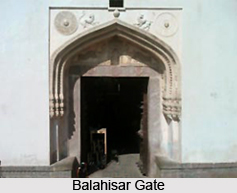 Entering the fort (daily 9am-5pm) by the Balahisar Gate, the travelers will reach the Grand Portico. Here guards clap their hands to show off the fort`s acoustics; the claps can be clearly heard at the Durbar Hall. To the right is the mortuary bath, where the bodies of deceased nobles were ritually bathed prior to burial. If one follows the arrowed anticlockwise route, it will lead him or her to the two-storey residence of ministers Akkana and Madanna before starting the stairway ascent to the Durbar Hall. Almost at the top, tourists come across the small, pretty mosque of Ibrahim Qutb Shah; beyond here, set beneath two huge granite stones, is an even tinier temple to Durga in her manifestation as Mahakali.
Entering the fort (daily 9am-5pm) by the Balahisar Gate, the travelers will reach the Grand Portico. Here guards clap their hands to show off the fort`s acoustics; the claps can be clearly heard at the Durbar Hall. To the right is the mortuary bath, where the bodies of deceased nobles were ritually bathed prior to burial. If one follows the arrowed anticlockwise route, it will lead him or her to the two-storey residence of ministers Akkana and Madanna before starting the stairway ascent to the Durbar Hall. Almost at the top, tourists come across the small, pretty mosque of Ibrahim Qutb Shah; beyond here, set beneath two huge granite stones, is an even tinier temple to Durga in her manifestation as Mahakali.
Warangal-"one stone"- 150 km northeast of Hyderabad, was the Hindu capital of the Kakatiyan Empire in the 12th and 13th centuries. Warangal`s fort, 4km south of town, is famous for its two circles of fortifications: the outer made of earth with a moat, and the inner of stone. Four roads into the centre meet at the ruined temple of Swayambhu dedicated to Shiva. At its southern, freestanding gateway, stands another Shiva temple, from the 14th century. Also inside the citadel is the Shirab Khan or Audience Hall, an early 11th century building very similar to Mandu`s Hindola Mahal.
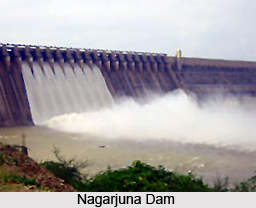 Nagarjunakonda or "Nagarjuna`s Hill", 166km south of Hyderabad and 175km west of Vijayawada, is all that now remains of the vast area, rich in archeological sites. It was here that the huge Nagarjuna Sagar Dam was built across the River Krishna in 1960. Ancient settlements in the valley were first discovered in 1926. Nagarjunakonda was once the summit of a hill, where a fort towered 200m above the valley floor.
Nagarjunakonda or "Nagarjuna`s Hill", 166km south of Hyderabad and 175km west of Vijayawada, is all that now remains of the vast area, rich in archeological sites. It was here that the huge Nagarjuna Sagar Dam was built across the River Krishna in 1960. Ancient settlements in the valley were first discovered in 1926. Nagarjunakonda was once the summit of a hill, where a fort towered 200m above the valley floor.
The museum here houses stone friezes decorated with scenes from the Buddha`s life and statues of Buddha in various postures. Earlier artefacts include stone tools and pots from the Neolithic age (third millennium BC) and metal axe heads and knives (first millennium BC). Later exhibits include inscribed pillars from Ikshvaku times showing Buddhist monasteries and statues. Medieval sculptures include a 13th century Tirthankar, a 17th century Ganesh and Nandi, and some 18th century Shiva and Shakti statues and there is also a model showing the excavated sites in the valley.
Exhibits at the small but fascinating museum in Amaravati range in date from the third century BC to the twelfth century AD and include Buddha statues with lotus symbols on the feet, tightly curled hair and long ear lobes. Other stone carvings show Buddhist symbols such as the wheel of dharma, throne, stupa and bodhi tree. Later sculptures include limestone statues of the goddess Tara and Bodhisattva Padmapatvi, showing that Mahayana teachings had taken over from the earlier Hinayana doctrines.
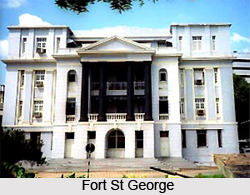 Besides these places the tourists can also droop in at the16th century Chandragiri lying 11km southwest of Tirupati. it became the third capital of the Vijayanagars whose power had declined following the fall of the city of Vijayanagar (Hampi) in Karnataka, It was here that the British negotiated the acquisition of the land to establish Fort St George, the earliest settlement at what is now Chennai.
Besides these places the tourists can also droop in at the16th century Chandragiri lying 11km southwest of Tirupati. it became the third capital of the Vijayanagars whose power had declined following the fall of the city of Vijayanagar (Hampi) in Karnataka, It was here that the British negotiated the acquisition of the land to establish Fort St George, the earliest settlement at what is now Chennai.
The original fort, thought to date from around 1000 AD, was taken over by Haider Ali in 1782, followed by the British in 1792. A small museum of sculpture, weapons and memorabilia is housed in the main building, the Indo-Saracenic Raja Mahal. Another building, the Rani Mahal, stands close by, while behind that is a hill with two freestanding boulders that was used as a place of public execution during Vijayanagar times. A little temple from the Krishna Deva Raya period and a freshwater tank stand at the top of the hill behind the Raja Mahal.



















